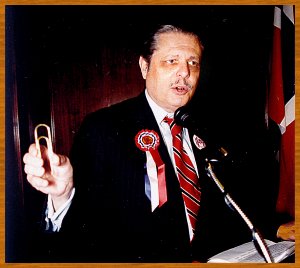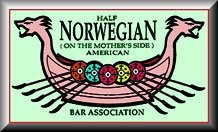

By Roger M. Grace
(The founder of the organization presented the following remarks on May 17, 2002. Two weeks earlier, a "raid" took place by district attorney's investigators at the offices of the newspaper company owned by his wife and himself.)
This is a paper clip. This particular one is large. But large or small, it is a mundane item used for — of all things — clipping papers.
So far, I would imagine, you are utterly astounded by the profundity of these remarks.
What some of you might not know is that a paperclip is also a piece of jewelry. More than that, it is an emblem, a symbol, a statement.
Who would wear a paperclip? A loyal Norwegian during the World War II occupation of the Kingdom of Norway.
Despite the legion of Norwegian contributions to humankind through the centuries in a multitude of fields — including invention of commonplace items like the ubiquitous paperclip, the cheese slicer, the gas turbine engine, and skis — it remains that the inhabitants of the kingdom are relatively few in number. Given Norway’s small population, resistance to the invasion by German forces, which began on April 9, 1940, was futile. Norway’s spirit, however, was unconquerable.
The invading forces proclaimed a ban on the wearing badges or broaches bearing the image or initials of the Norwegian king, Haakon VII, who was in exile in England (along with the rest of those who comprised the lawful government of Norway). Norwegians responded to the decree by wearing the paperclip, invented by Norwegian Johann Vaaler and patented by him in Germany in 1899. Paperclips were affixed to pockets, collars, cuffs, lapels and hemlines. They were worn as a show of solidarity — after all, the purpose of the paperclip is to bind — and also a symbol of defiance to unlawful authority.
An untold number of Norwegians were arrested for the simple act of wearing a paperclip. In his book, "Of Norwegian Ways," Bent Vanberg writes: "Loyal Norwegians wore the clip proudly, knowing well that they risked arrest, deportation, imprisonment, and even execution by displaying this simple sign of their true feelings."
Experiencing a three-hour occupation by armed invading forces, as we at the Metropolitan News-Enterprise did on May 2, provided a microcosmic insight into what the Norwegians suffered during the five-year period from 1940-45 when their nation was infested with intruders.
In case you haven’t read about it, DA’s investigators wanted some business records we had relating to publication of three legal notices announcing an intent to circulate recall petitions; we offered to turn over the records if they would send us a subpoena; instead, they served a search warrant. To any newspaper, service of a search warrant is an act of aggression, carrying with it, as it does, the threat of a search, the prospect of government investigators learning identities of confidential informants and seeing unpublished information. While we were perfectly willing to let the investigators have the papers relating to the three legal ads in response to a subpoena, my wife and I declined to relinquish them based on the warrant. It was up to the investigators try to find them. Our entire staff was ejected from the premises.
I talked with DA Steve Cooley by telephone, complaining of the presence of his "storm troopers" in our offices, and entreating him to consider alternative approaches. He said he did not need to work things out because "we have a search warrant." In the end, I determined the DA’s office already knew what law firm had placed the legal notices with us, so that we did not have a customer whose privacy interests needed protection, and we released the documents — but only after being shut down for three hours.
Despite public protestations by Cooley to the contrary, the search warrant was illegal on its face. It was issued in contravention of 42 U.S.C. §2000aa. Searches of newspaper offices are lawful under that federal statute only if certain narrow circumstances exist, such as where "the person possessing such materials has committed or is committing the criminal offense to which the materials relate." I don’t know of anyone at our newspaper having committed any crime, let alone a crime relating to the publication of the legal notices in question. The only crimes I know of which were arguably committed on our premises were those of the intruders.
I e-mailed to just about everybody in my address book the link to Marc Haefele’s column in the L.A. Weekly lambasting the invasion of our premises. Håkon Bjerke, a law librarian born in Norway and now residing in Hawaii, sent back this message:
"What a breakdown in the legal system to concoct this raid. I hope these roughnecks from the DA's office did not hurt you folks physically. This is a raid in the best gestapo style. All in a sudden I felt the clock was turned back 60 years. Coming from a country that once was occupied by the Nazis I can not help think otherwise. One is tempted to think the DA took some lessons from the darker forces in history. Outrageous, simply outrageous."
I wrote back to Håkon that I was going to present this talk, and asked permission to share his e-mail with you. He consented, and remarked:
"Good luck with your meeting and speech, and yes do use the paperclip and remind our half-cousins what the norskies went through 62 years ago."
This group hosts a website called the Norwegian American Homepage. A Norwegian who has supplied much information for that website is Tor Kvien, who manages a department of a city near Oslo. Here’s his reaction:
"What you tell me makes me think of the Nazis stopping the free press during WW II, or similar cases in the USSR, communist states and dictatorships. I did not think this was possible in the world’s greatest democracy."
I didn’t either.
Trygve Strøm, who works in Oslo for Norway's leading power producer, has made numerous suggestions for additions to the Norwegian-American Hall of Fame on our website. He commented that "raids on newspapers" are a "no-no" in Norway and that "police invading newsooms is something we connect with countries quite different from ours."
This morning, I received an e-mail from Solveig Hansen, a social commentator in Oslo, who remarked:
"...I believe the word 'scandal' would be an appropriate one if something similar were to happen here — or elsewhere for that matter. I would have thought there were other ways for the DA's office to obtain that info — provided they were entitled to the info in the first place — than the one cowboy Cooley chose in the end."
I queried the newspaper Aftenposten, in Oslo, about occurrences of government searches of newspaper offices in Norway. This response came from Nina Berglund:
"I've talked with some colleagues here at Aftenposten, Norway's biggest broadsheet, and they can recall only one case of a post-war newsroom search, back in the 1970s, and details were fuzzy. Nothing in recent memory.
"News organizations, including Aftenposten, have been hit with court orders to turn over notes or film. But the media generally have refused, and paid fines. In one fairly recent case, our editor Einar Hanseid was ordered to ‘utlevere’ [turn over] film taken by a staff photographer in a murder case, but he refused to do so. No newsroom searches or seizures took place."
Author Michael Holmboe Meyer of Stavanger also recalls that there has been only one search of a newspaper office in Norway since the end of the war. He recounted in an e-mail that "[d]uring the occupation of Norway…, I believe it was very common."
The author noted, as did Trygve Strøm, that there was a search in 1999 of the Brussels office of the newspaper Stavanger Aftenblad. Its correspondent, Stein Viksveen, was suspected of working clandescently for the East German secret police from 1962 until the fall of the Berlin Wall in 1989, and passing them secret NATO documents. Norway’s Supreme Court on March 16, 2000 spurned a challenge to a lower court’s ruling that illegality had surrounded the seizure of papers by the Norwegian Secret Police and Belgian authorities. It left undisturbed the determination that the papers would have to be sifted through in camera to redact any material that would disclose the identities of news sources. Charges against Viksveen were dropped last Nov. 2.
Had that search occurred in the United States, it would have been legal, under an exception to an exception to an exception in §2000aa. A "national security" provision would have prevailed.
However, on May 2, when Cooley’s Goon Squad staged its invasion of our premises, national security was not implicated, nor did any other circumstance render the intrusion lawful. There was…
• No criminal activity on our part;
• No child pornography involved;
• No need "to prevent the death of, or serious bodily injury to, a human being";
• No threat of a destruction of the materials — materials we had agreed to relinquish upon receipt of a subpoena.
And, obviously, this was not an instance where a subpoena had been served but snubbed.
None of the exceptions to §2000aa existed.
I only wish that the 25-30 staff members, waiting outside our premises during the raid, had sported paperclips. It would have been appropriate.
In Oslo, there is a memorial to Johann Vaaler — a 23-foot statue — in the form of a paperclip. In 1999, Norway issued a stamp, bearing a depiction of Vaaler’s invention 100 years earlier.
So, when you
see a paperclip, remember it is a Norwegian
invention — and a symbol of defiance to unlawful
authority. In the aftermath of the Gestapo-like
seizure of our newspaper office two weeks ago, I
believe I am justified in wearing this paperclip
today.
